The Whale Galaxy is a barred spiral galaxy located at an approximate distance of 30 million light years in the constellation Canes Venatici. It has an apparent magnitude of 9.8 and appears almost edge-on. It has been nicknamed the Whale because of its elongated, slightly triangular shape that resembles the profile of the whale. The galaxy has the designation NGC 4631 in the New General Catalogue.
The optical disk of NGC 4631 occupies an area of 15’.5 by 2’.7 of the apparent sky. The galaxy is interacting with a smaller companion, the dwarf elliptical galaxy NGC 4627, which lies just to the north. NGC 4627 has an apparent magnitude of 13.1 and occupies an area of 2′.6 × 1′.8. The two galaxies were catalogued as Arp 281 in the Atlas of Peculiar Galaxies. The American astronomer Halton Arp, who produced the Atlas in 1966, listed the pair as an example of a galaxy pair or a “double galaxy.” The smaller galaxy is often referred to as the Pup.
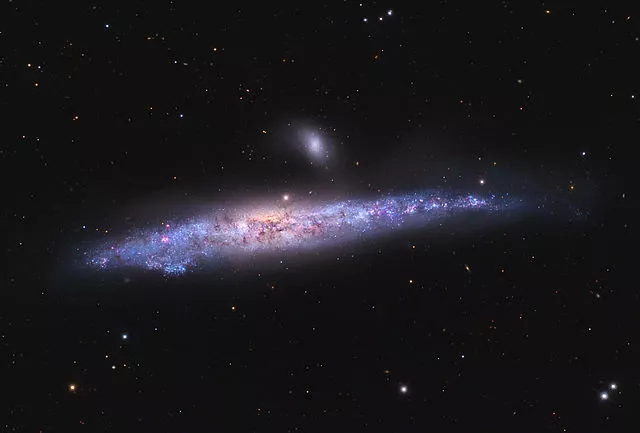
The Whale Galaxy (NGC 4631), image: Adam Block/Mount Lemmon SkyCenter/University of Arizona (CC BY-SA 3.0 US)
The Whale Galaxy is the central member of the NGC 4631 Group, a group of galaxies located about 25 million light years away. The group is part of the Virgo Supercluster. The member galaxies lie both in Canes Venatici and in the neighbouring Coma Berenices. They include NGC 4627, the companion of NGC 4631, and the relatively bright Hockey Stick Galaxies (NGC 4656 and NGC 4657). The membership of other galaxies that appear close by is uncertain. Some studies estimate as few as five members, while others estimate as many as 27.
The Whale Galaxy is recognizable for its central starburst region, appearing roughly spheroidal in shape, and a long, rugged tail. The most massive stars formed in starburst regions do not live very long lives. They burn through the supply of hydrogen in their cores relatively quickly and go out as supernovae not long after evolving away from the main sequence. The many supernovae in the galaxy’s nucleus are blowing gas out of the galaxy’s plane. The superwind was detected by X-ray observations with the ROSAT satellite in the early 1990s.

The NASA/ESA Hubble Space Telescope has peered deep into NGC 4631, better known as the Whale Galaxy. Here, a profusion of starbirth lights up the galactic centre, revealing bands of dark material between us and the starburst. The galaxy’s activity tapers off in its outer regions where there are fewer stars and less dust, but these are still punctuated by pockets of star formation. The Whale Galaxy is about 30 million light-years away from us in the constellation of Canes Venatici (The Hunting Dogs) and is a spiral galaxy much like the Milky Way. From our vantage point, however, we see the Whale Galaxy edge-on, seeing its glowing centre through dusty spiral arms. The galaxy’s central bulge and asymmetric tapering disc have suggested the shape of a whale or a herring to past observers. Image: ESA/Hubble & NASA
Facts
The Whale Galaxy is a frequent target for studies. Because of its relative proximity, it helps astronomers study the stars and gas that lie outside the galactic plane.
A 1992 study found a highly irregular distribution of H-alpha (Hα), indicating that the galaxy’s disk was disturbed, likely as a result of interaction with smaller nearby galaxies. The study also found a double-worm structure above the galaxy’s central region, suggesting the breakout of a superbubble created by a star-forming event in the galaxy’s core.
The ROSAT observations in the 1990s found the strongest X-ray emission in the galaxy’s halo above the central disk, in a region that shows high star formation activity. The researchers presented evidence for interaction between the galaxy’s disk and halo. The hot gas appears to blow out from supershells in the disk, dragging magnetic field lines up in the halo and forming a magnetized gaseous halo. The galaxy’s giant diffuse halo extends as far away as 8 kiloparsecs from the galactic plane. It was detected by the Chandra X-ray Observatory in 2001.
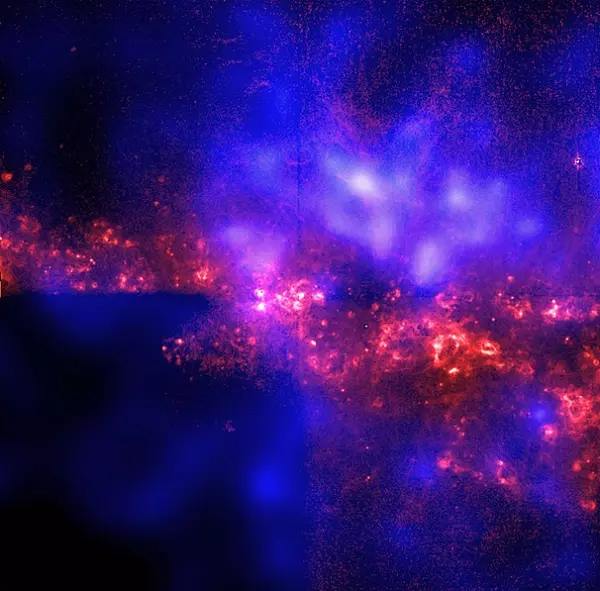
Chandra’s observations of NGC 4631 reveal a giant halo of hot gas (shown in blue and purple) surrounding this spiral galaxy. The structure across the middle of the image and the extended faint filaments (shown in orange) represent data from the Hubble Space Telescope that reveal giant bursting bubbles created by merging clusters of massive stars. NGC 4631 closely resembles our Milky Way galaxy, and observations of NGC 4631 and similar galaxies provide astronomers with an important tool in the understanding our own galactic environment. Image: Smithsonian Institution, X-ray: NASA/CXC/UMass/D.Wang et al.
The magnetic fields were first imaged with the Karl G. Jansky Very Large Array radio telescope in 2019. The images seemed to confirm a classical theory about dynamos (magnetic generators) generating the fields. The researchers’ dynamo model produced spiraling magnetic fields in the galaxy’s halo that were an extension of the spiral arms in the galaxy’s disk.
NGC 4631 is not the only whale in the sky. The barred spiral galaxy NGC 55, located in the constellation Sculptor, is similarly whale-like in appearance and shares the nickname with NGC 4631. NGC 55 is slightly brighter (mag. 7.87) and closer at a distance of about 6.5 million light years. It is a member of the Sculptor Group of galaxies, one of the closest groups to the Local Group of galaxies.
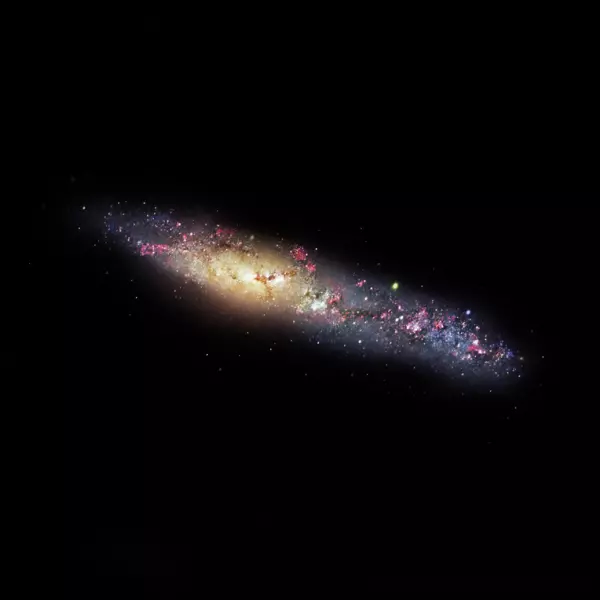
NGC 55, image: Pablo Carlos Budassi (CC BY-SA 4.0)
Location
The Whale Galaxy (NGC 4631) is not too difficult to find because it lies in the area between two bright stars: Cor Caroli, the luminary of Canes Venatici, and Denebola at the tail of Leo. Cor Caroli is found directly below Alkaid, the star at the tip of Big Dipper’s handle, and Denebola lies just east (left) of the Sickle, the asterism that outlines Leo’s head and mane. NGC 4631 lies about 6 degrees south of Cor Caroli, in the direction of Denebola.
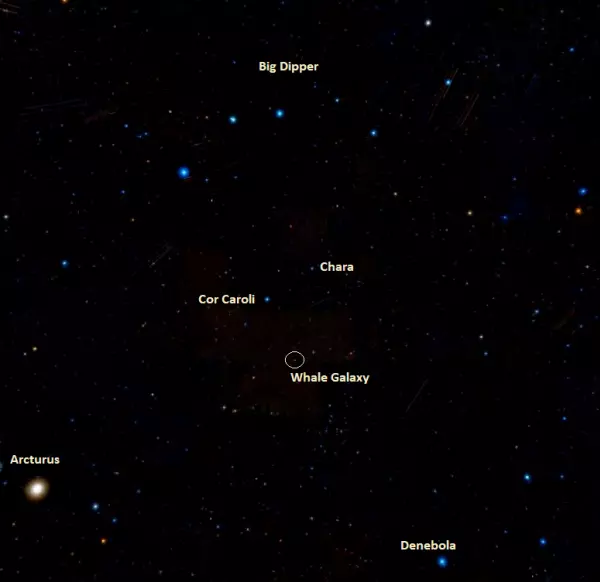
The location of the Whale Galaxy (NGC 4631), image: Wikisky
The Hockey Stick Galaxies (NGC 4656 and NGC 4657) appear in the same field of view as the Whale. The colliding galaxies are found just to the southeast.
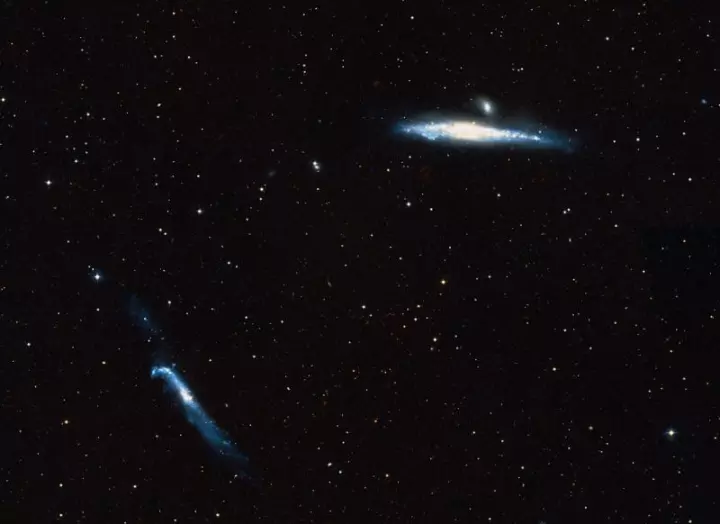
The Whale Galaxy and the Hockey Stick Galaxies, image: Wikisky
Whale Galaxy – NGC 4631
| Type | SB(s)d |
| Constellation | Canes Venatici |
| Right ascension | 12h 42m 08.009s |
| Declination | +32° 32′ 29.44″ |
| Apparent magnitude | 9.8 |
| Apparent size | 15′.5 × 2′.7 |
| Redshift | 606 ± 3 km/s |
| Distance | 30 million light years |
| Names and designations | Whale Galaxy, NGC 4631, Arp 281, PGC 42637, UGC 7865, Caldwell 32, IRAS 12396+3249, MCG+06-28-020, 2MASX J12420800+3232294 |